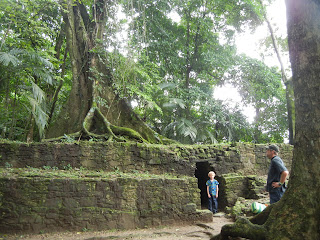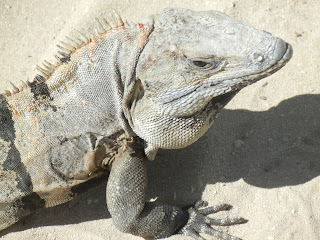Well it seems a bit strange to be finishing our 7 months of Latin American travel in Puerto Vallarta, a place which really, seems sort of Canadian, right down to the Stanley Cup playoff games on the tvs in the pubs to the Mexican ponchos sporting hockey logos....
Since last I wrote, we made our way through the lovely (and elegant) colonial city of Morelia and then headed to the small coastal town of San Blas 4 hours north of Puerto Vallarta. We enjoyed our days in that pleasant, friendly and authentically Mexican town full of all sorts of intriguing history... pirate invasions, 100s of years of smuggling and more recently visits from the likes of Ernest Hemingway & Jim Morrison. A nice town to visit.
Also, the Huichol indigenous culture is still very strong in this area. Nearby Isla del Rey is sacred to the Huichol people who do ceremony to honour Mother Earth. Here on the seemingly endless beach we discovered the remnants of a recent ceremony. Many offerings were also tucked in under the rocks, candles, feathers, weavings and other items.
Now in Vallarta, sitting poolside until our flight for Vancouver departs tomorrow, we have pause to reflect on our wanderings over the last 7 months...
In fact, this trip began a long time before our departure with all the planning, thinking and decision making we had to do... where and when to go? How would we afford it? How scary would it be? Would it be safe? What about school demands? What about our house? .....
What about our lives? We spent months planning passports, bills, budget, vaccinations and medications (many which we found to be unnecessary), insurance.... it was a long list, and I realize now, I kind of need these couple of days to sit around here in Vallarta and do nothing. Time for reflection and relaxation... We are kind of overwhelmed by the magnitude of the experiences we have had and the beautiful people we have met along the way, many of whom who have been incredibly inspiring. Some friends have said - it will take a while to process it all and realize the full impact of this trip on all of our lives. I think they are right.
Now, it is time to explore & fully appreciate the incredible beauty of our own homeland.
Canada, here we come ...
Since last I wrote, we made our way through the lovely (and elegant) colonial city of Morelia and then headed to the small coastal town of San Blas 4 hours north of Puerto Vallarta. We enjoyed our days in that pleasant, friendly and authentically Mexican town full of all sorts of intriguing history... pirate invasions, 100s of years of smuggling and more recently visits from the likes of Ernest Hemingway & Jim Morrison. A nice town to visit.
horse riding on Playa Borrego, San Blas
The mainstay of the San Blas economy remains fishing & there is no shortage of delicious and inexpensive seafood available.
Also, the Huichol indigenous culture is still very strong in this area. Nearby Isla del Rey is sacred to the Huichol people who do ceremony to honour Mother Earth. Here on the seemingly endless beach we discovered the remnants of a recent ceremony. Many offerings were also tucked in under the rocks, candles, feathers, weavings and other items.
Now in Vallarta, sitting poolside until our flight for Vancouver departs tomorrow, we have pause to reflect on our wanderings over the last 7 months...
In fact, this trip began a long time before our departure with all the planning, thinking and decision making we had to do... where and when to go? How would we afford it? How scary would it be? Would it be safe? What about school demands? What about our house? .....
What about our lives? We spent months planning passports, bills, budget, vaccinations and medications (many which we found to be unnecessary), insurance.... it was a long list, and I realize now, I kind of need these couple of days to sit around here in Vallarta and do nothing. Time for reflection and relaxation... We are kind of overwhelmed by the magnitude of the experiences we have had and the beautiful people we have met along the way, many of whom who have been incredibly inspiring. Some friends have said - it will take a while to process it all and realize the full impact of this trip on all of our lives. I think they are right.
All I can say is, I am glad we did it.... and when we get back to Canada, the adventure will continue...Now, it is time to explore & fully appreciate the incredible beauty of our own homeland.
Canada, here we come ...






















































